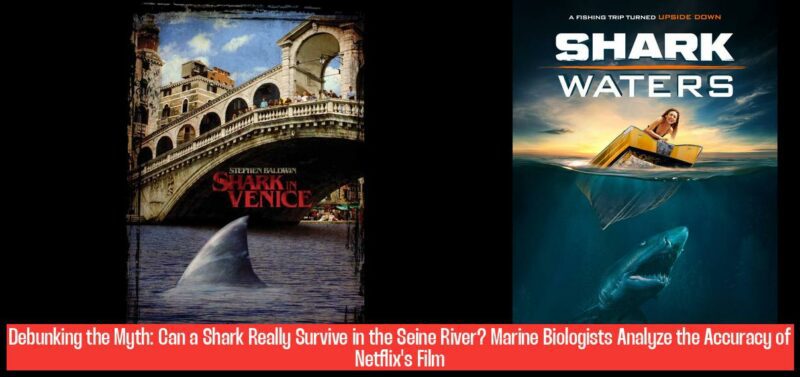Can a Shark Really Survive in the Seine?
Ahoy, ocean enthusiasts! Today, we dive into the deep waters of controversy surrounding the Netflix movie “Under the Waters of the Seine,” where a giant shark prowls through the iconic Parisian river. Picture this: Parisians might swap their iconic berets for scuba gear if this scenario were real!
Let’s tackle the burning question: Can a shark truly survive in the Seine? Well, two marine biologists, Armelle Jung and Paul Abaut, from the French association Des Requins et des hommes, have some fin-tastic insights to share.
Can a Shark Really Survive in the Seine?
So, here’s the scoop – according to Paul Abaut and Armelle Jung, tagging along with sharks in freshwater habitats like the Seine is like trying to make a fish climb a tree; completely out of their element! The movie features a mako shark, primarily an oceanic species that thrives in salty seawater. As Paul points out, “Putting a mako shark in freshwater like the Seine is like expecting a polar bear to enjoy a tropical vacation—it’s just not their vibe!”
Armelle adds to this fishy tale by shedding light on some high-tech gizmos shown in tracking sharks in the film that would make James Bond envious! But surprise-surprise, these devices are more fiction than science reality. Talk about Hollywood magic playing tricks on our favorite marine predators!
Now onto Part Two of our show – “The Myth of Man-Eating Sharks.” In reality—brace yourselves—not all sharks dream of human sushi rolls! Paul dismisses this fear-fed frenzy by highlighting that sharks aren’t lurking around for humans on their menu; it’s more like an accidental nibble rather than targeted takeout.
Adding flair to our marine gossip column is Armelle’s take – portraying sharks as misunderstood introverts rather than blood-thirsty brutes. So next time you’re at sea and spot a shark nearby, think less Jaws blockbuster and more Finding Nemo friendship potential!
ASOG Fact: Did you know that sharks are picky eaters? Some species prefer specific types of prey while others munch on whatever floats by—just surfing through life one snack at a time!
Lastly, science takes center stage with criticisms on ‘Shark’s Fast & Furious: Reproduction Edition.’ The film glams up shark reproduction fantasies with fairy-tale partenogenesis scenarios where mama sharks skip dating apps for solo parenting. Hold your horses – or should we say fishes–as Paul pops this bubble by revealing that real-life shark romance happens slowly and partenogenesis isn’t exactly The Bachelor finale material.
Before we wrap up our underwater drama extravaganza unraveling in Paris’ backyard pool let’s reflect on balancing cinema creativity with scientific straight face. While movies often jazz up facts for entertainment (we see you CGI Mako), truth should still be swimming somewhere amidst all those fancy ocean graphics.
If you’re hooked like a sardine on these revelations about our finned friends or curious about what’s lurking beneath cinematic tides continue reading as we unravel more aquatic enigmas coming your way! Stay tuned and don’t forget your floaties!
Scientific Inaccuracies in ‘Under the Waters of the Seine’
Trending Now — Who Portrays Sabretooth in the ‘Deadpool & Wolverine’ Clip?
In the Netflix movie “Under the Waters of the Seine,” scientific inaccuracies abound like seaweed in a tide pool. While the film’s suspenseful premise of a deadly shark lurking in Paris’ River Seine may make your heart race faster than a cheetah on espresso, it’s about as plausible as finding a mermaid hosting a tea party on the Eiffel Tower. The reality check hits hard as no shark sightings have been recorded in this iconic river, making the movie more of a fantasy swim than a documentary dive. So, before you start packing your shark repellent for a stroll along the Seine, remember that Hollywood’s imagination can sometimes stretch wider than an octopus’s embrace.
Now let’s dissect these oceanic missteps with some scientific scalpel precision: First off, sharks are saltwater sweethearts whose gills would throw a tantrum if exposed to freshwater like the Seine. It’s like trying to teach an octopus ballet— they’re just not built for it! Additionally, the film’s portrayal of high-tech tracking devices on sharks may seem cutting-edge, but in reality, it’s more sci-fi fantasy than marine biology.
Moreover, let’s debunk another fishy myth – sharks devouring humans like sushi rolls. Contrary to cinematic scares, sharks aren’t prowling around for humans as their next meal deal; imagine more accidental nibbles instead of targeted takeouts. They’re more into fish fillet specials rather than human finger foods.
As we paddle through these murky waters of misinformation, it’s vital to separate fact from fiction with aquatic clarity. While cinematic liberties add spice to storytelling (we’re looking at you CGI shark), keeping one flipper in reality waters ensures we don’t fall prey to misleading movie magic hook, line, and sinker.
So next time you catch yourself dreaming of swimming alongside JAWS’ distant cousin in Paris’ beloved River Seine or imagining sharks as underwater assassins aiming for human olive garnishes—just remember that science reigns supreme even amidst Hollywood’s splashy spectacles. A little skepticism and fact-checking never hurt anyone—even if it means bursting your shark-shaped bubble bath fantasies!
Hopefully clear skies and calm seas lie ahead as we navigate through more aquatic mysteries and bring light to sensationalized cinema tales plaguing our rational marine minds! Stay tuned for more revelations bubbling up from beneath the surface!
Marine Biologists Debunk Netflix’s Shark Film
Marine Biologists Debunk Netflix’s Shark Film: Ahoy, ocean adventurers! Today, let’s dive into the depths of the Netflix movie sensation “Under the Waters of the Seine,” which imagines a giant shark prowling through Paris’ iconic river. But hold onto your surfboards because reality meets fiction as we unravel why having a shark in the Seine is like trying to fit a square peg into a round hole – utterly fishy! So, let’s set sail with marine biologists Armelle Jung and Paul Abaut as they debunk this aquatic fantasy.
Can a Shark Truly Survive in the Seine? Picture this: expecting a mako shark, an oceanic marvel, to thrive in freshwater like the Seine is as likely as spotting a penguin swimming at a tropical beach party—it’s just not their jam! Our marine experts give us fin-tastic clarity on how sharks sticking to freshwater habitats is about as probable as finding buried treasure under your neighbor’s goldfish pond.
In From Aquatic Myths to Realities: Floaties up for argument #2: “The Myth of Man-Eating Sharks.” Brace yourselves—sharks aren’t cruising around looking for humans on their ‘sushi tonight’ menu; it’s more like mistaking your finger for that delicious squid ring you ordered. Think accidental snacks rather than planned banquets when these apex predators are navigating ocean corridors!
Sharks: Misunderstood Introverts or Fierce Predators? Armelle spices up our underwater narrative by flipping the script from bloodthirsty villains to misunderstood introverts. Forget Jaws-esque primal instincts; these stealthy swimmers prefer sharing chilling waters with fish buddies over human chit-chat. So put down that harpoon and extend a virtual handshake next time you meet jaws in seawater – who knows, maybe they’ll just want to gossip about coral reefs!
Science Meets Hollywood Dramatics: Now armed with facts sharper than shark teeth, we circle back to dissecting Netflix’s ‘Shark’s Fast & Furious: Reproduction Edition.’ Expectation versus reality hits home when real-life romance trumps Hollywood’s fantastical partenogenesis plots; sharks prefer slow dances over speed dating escapades.
As we navigate through this sea of misinformation, remember that separating fact from fiction in cinematic seas ensures our minds stay as sharp as a great white tooth. So before you start packing your anti-shark moat for a Parisian river stroll inspired by Netflix fantasies, remember—keeping one eye on scientific reality prevents becoming fish bait for misleading movie magic hook, line, and sinker! Stay tuned for more aquatic adventures splashing up from beneath cinematic tides wiggle fins—intriguing revelations await your curious minds!
Can a shark really survive in the Seine River?
According to marine biologists Armelle Jung and Paul Abaut, the portrayal of a mako shark in the freshwater environment of the Seine River in the Netflix movie “Under the Waters of the Seine” deviates significantly from established scientific facts about sharks.
What concerns do marine biologists have about the accuracy of the shark representation in the Netflix film?
Armelle Jung and Paul Abaut, marine biologists working for the French association Des Requins et des hommes, raise concerns about the inaccuracies in the movie, such as the presence of a pelagic mako shark in a freshwater environment like the Seine River, which is not its natural habitat.
What technological inaccuracies related to shark tracking are highlighted by Armelle Jung in the film?
Armelle Jung points out that the tracking methods shown in the movie, such as using a small laptop to track a shark in real-time, are improbable and do not exist in reality, contrary to what is depicted in the film.
What is the main error highlighted by Paul Abaut regarding the presence of a mako shark in the Seine River?
Paul Abaut emphasizes the fundamental error in the film’s plot, stating that a pelagic mako shark, which typically inhabits saltwater oceans, would not survive in the freshwater environment of the Seine River as portrayed in the movie.



